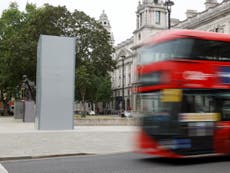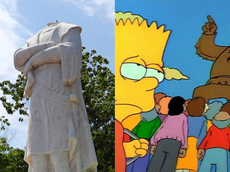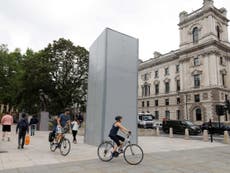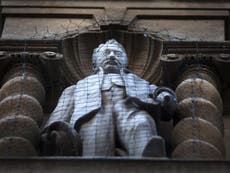Statues of slavery benefactors sparked protests more than 100 years ago – this isn't a new debate
It would be fitting to replace the monument that was seen as a symbol of oppression in 1882 with a dedication to the woman who fought against it
In recent days we’ve seen the return to our mainstream and social media of three familiar and tiresome old fallacies:
"They’ll be tearing down the pyramids next!"
"History is being destroyed by thugs!"
‘"Everyone was racist Back Then!"
The unholy trio has been working overtime in the services of what we might call the "anti-Topplers" since Edward Colston’s unexpected dunking in Bristol.
It’s disappointing to see some historians employing them as well, since they of all people should know that tearing down the old IS an historical tradition.
The "Slippery Slope Fallacy" about pyramids overlooks the fact only one person ever seriously worked to destroy the-12th century Sultan of Egypt Al-Aziz Uthman (he only gave up because they were too well built!)
"History" is nothing if not a constantly changing record of what some people consider important at any one time. Because, as the truism runs, it’s so often written by "the victors", it is and should be subject to fresh perspectives.
Monuments rise and fall in line with our ever-changing relationship with the past.
Ancient Egyptians erased memorials to rulers who'd slipped from favour, like Pharaoh Hatshepsut, who brought great economic prosperity but was, unforgivably, female.
The Romans actually made "destroying" history the law – Damnatio memoriae, "condemnation of memory", was a legal sentence the Senate could enact to force compulsory "forgetting" of those judged to have dishonoured the Roman state.
Henry VIII did the same for any number of historic (even then) monasteries and cathedrals.
In America, on hearing the Declaration of Independence for the first time, colonists toppled a Manhattan statue of King George III – and in an apt act of recycling, repurposed the lead as bullets for the Revolutionary War.
Yet George III is not forgotten, any more than Hitler, Stalin or Mussolini, whose statues also got nixed – or Saddam Hussein, whose monuments many of today’s right-wing "anti-topplers" were delighted to see bite the dust.
It seems "thuggishness" is dependent on the actors. When Lord Mandelson called Colston’s demise result of the "law of the jungle", it was an unfortunate echo of an old racist trope about animalistic, violent black people
The "everyone used to be racist" line doesn’t stand up any better than Colston’s statue now.
It overlooks the fact that there’s never been a time when "everyone" in Britain was white.
And, as Femi Nylander, founder of Rhodes Must Fall, told me previously:
"Not every historical figure was a white supremacist, or sexist. Plenty of people in the 18th century were fighting racism and sexism. Simply to say everyone in the past had some dodgy views is a copout."
British abolitionists fought against slavery from the 1700s. The first anti-racist journal was established in 1888.
The good news is that there are plenty of candidates for those empty podiums – including those who escaped enslavement.
Like Ignatius Sancho, composer and actor, painted by Gainsborough in 1768, and the first black voter in Britain. His wise, witty "Letters" were published in 1782
Or Olaudah Equiano, born in Benin in 1745, who made it to freedom to become a writer and abolitionist of note
Like Ukawsaw Gronniosaw, tricked into slavery at 15, who came to Britain and wrote his life story as a free man in 1772.
Or Mary Prince, born into slavery in Bermuda and brought to England where she escaped, and, despite terrible sufferings to win her freedom, became the first back woman to publish her life story in Britain, in 1831. Her book galvanised the Abolition movement.
As there’s talk of removing a statue I’ve written a lot about, of William Gladstone on Bow Road in east London, we should also consider honouring the women forced to pay for it in 1882. They were both called "white slaves" and considered black by Victorian eugenicists, who categorised those of Irish descent as "negroid".
The unveiling took place in 1882 at the behest of their hugely wealthy bosses Bryant and May, who’d forced the matchwomen to pay for the statue from already starvation wages.
The firm made workers attend the ceremony – but watched in horror as the women turned it into a protest, attacking the statue with rocks, jabbing their fingers with hatpins to stain it red, and shouting "our blood paid for this!"
Despite having no union and being at the bottom of the labour hierarchy, the matchwomen went on all-out strike in 1888, taking on a ruthless employer: and winning. They formed the largest union of women and girls in the country, launching the modern union movement.
How appropriate to replace the statue the women hated as a symbol of oppression, with a GROUP statue of them.
And we must remember them collectively because, like the many women who make up Black Lives Matter protestors today, they didn’t believe in leaders, just unity, sisterhood and solidarity.
Dr Louise Raw is the author of Striking a Light (Bloomsbury Press) on the Bryant and May Matchwomen. Follow her campaign to build a statue to the Bow Matchwomen on Twitter or Facebook






Join our commenting forum
Join thought-provoking conversations, follow other Independent readers and see their replies